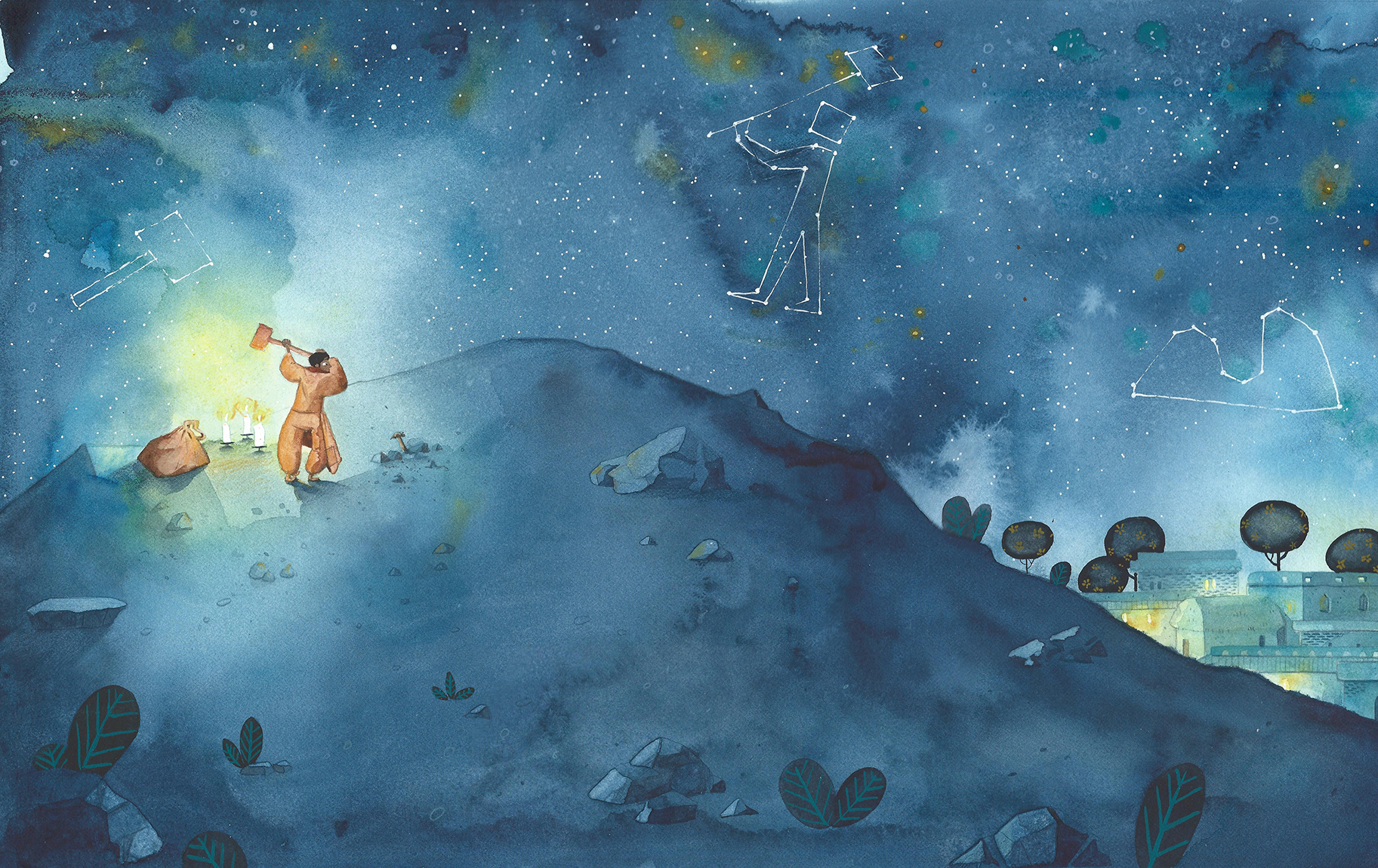People who do things to help others without the desire for reward inspire me. They walk humbly among us, but they are the true treasures of this world. Every time I spot one, I think of the Jewish legend of the Lamed Vovniks, the 36 people in every generation whose goodness saves humanity.
Among the wonderful qualities of these pillars of the world is that they are so humble, they don’t think of themselves as righteous or holy . They care for others because it’s the right thing to do. In their minds, isn’t that what everyone should do? They are all too rare, but they are also right.
Jadav Payeng, the hero of Sophia Gholz’s beautiful book, The Boy Who Grew a Forest, the True Story of Jadav Payeng, literally saves his world by planting trees in a desolated patch of his Indian community. Lushly illustrated by Kayla Harren, and published by Sleeping Bear Press on March 15, the story begins:
“In India, on a large river island, among farms and families hard at work, there lived a boy who loved trees.”
But trees are just the start of Jadav’s amazing journey. After planting tree after tree, he brings a 1,300-acre forest into being. Native plants and animals follow. Sophia’s book gave me the same thrill I had when I discovered Dashrath Manjhi, who became the hero of my Manjhi Moves a Mountain, with lyrical watercolors by Danny Popovici, from Creston Books (distributed by Lerner Books).
Manjhi Moves a Mountain, illustrated by Danny Popovici
Manjhi, also from India, spent 22 years chiseling a path through a 300-foot mountain so the children in his poor village could get to school on the other side, the sick could get to doctors and the elderly and those who were not as skilled at climbing as he could get to the work or shop.
Sophia sees the connection. As she wrote me in an email:
“Both The Boy Who Grew A Forest and Manjhi Moves A Mountain focus on the power of the individual and how it only takes one person with a dream to make a difference. Manjhi's and Jadav's stories are those of hard work and the simple and selfless desire to help others.”
Persistence, rather than strength or riches or power becomes the key to their success. In Sophia’s words:
“Mountains can’t be moved in a day, and forests don’t grow overnight. When the work was hard, when their journey seemed impossible, when others thought they were crazy, neither of these individuals gave up. Instead, they slowly kept chiseling and planting one rock, one seedling, one day at a time.”
Manjhi Moves a Mountain, illustrated by Danny Popovici
Most children’s book biographies focus on famous people. Let’s face it, it’s easier to sell a book on the person who invented this or the person who won that.
But Jadav and Manjhi aren’t big or strong or famous. They’re unskilled laborers who were strong in their hearts, as we can all be strong in our hearts. That is a very important lesson for kids, one that nourish them not only through school but throughout their lives.
Too often kids — and adults — think of life in terms of winners and losers. The winners of the championship. The star of the school play. The highest score on the test.
But guess what? The majority of us don’t win the championship or star in the school play or get a perfect score on the test. However there is something that we can all achieve throughout the school years and beyond. We can all be kind. We can all make a positive difference in the world.
And persistence — that quality that Jadav and Manjhi have in abundance — that can be a more powerful determinant than talent in getting you where you want to go.
As Calvin Coolidge said: “Nothing in this world can take the place of persistence. Talent will not: nothing is more common than unsuccessful men with talent. Genius will not; unrewarded genius is almost a proverb. Education will not: the world is full of educated derelicts. Persistence and determination alone are omnipotent.”
One of the reasons I was so determined to tell Manjhi’s story is that in my own small way, I felt I lived it. My first book, The William Hoy Story, How a Deaf Baseball Player Changed the Game took 13 years from the time I promised my friend, Steve Sandy, a friend of the Hoy family, that I would write the book and the year, 2016, when it was published. Persistence and my belief that a promise made must be fulfilled no matter how many times people raise their eyebrows or laugh or whisper just close enough for you to hear: “Is she really still working on that thing?”
Sophia is also someone who knows about persistence.
Like Jadav, Sophia invests in the community, caring for future generations with longterm projects aimed at benefiting children she has yet to meet. Since 2017, she has helped oversee The Henry L. Gholz SEEDS (Strategies for Ecology Education, Diversity and Sustainability) National Field Trip Endowment for the Ecological Society of America, in honor of her late father, esteemed scientist Henry L. Gholz. SEEDS provides opportunities for underrepresented students to participate and lead in ecology by sponsoring field trips that help explore the broad range of ecological research.
She’s also a board member of KidLiteracy, Inc., a brilliantly innovative nonprofit organization that raises money to bring books and author visits to schools in need. With both SEEDS and KidLiteracy, she helps plant seeds that are already growing into wonderful opportunities to make a positive difference in the world.
Both Sophia and I had our work cut out for us by writing about heroes who were not glamorous.
I’ll admit that I worried if Manjhi Moves a Mountain would find readers that would care about an ordinary laborer who spent 22 years chiseling a path through a mountain. But the critics and the kids took him to their hearts right away. A Junior Library Guild selection, winner of the 2018 South Asia Book Award, the 2019 Anne Izard Storytellers’ Choice Award and more, kids love to help me tell the story, repeating the words “Hold. Aim. Swing!” as Manjhi strikes his chisel.
Jadav’s story has connected with the critics, too. The book has been featured on many prominent lists. The School Library Journal called it an "inspirational read aloud" and Booklist said "Payeng's story is eloquently told and beautifully illustrated. It will inspire readers to recognize the power of individual determination."
Manjhi Moves a Mountain, illustrated by Danny Popovici
The kids understood that what Manhi was all about was the fact that we can all move mountains. That we can all make things better.
And to that thought I can now add Jadav Payeng’s lesson — that we can all plant a seed. We can all make something grow. And that every time we plant something, the growth brings unexpected miracles. Payeng’s forest brought back the birds and the insects and the animals. It brought back fresh, healing air. It brought joy.
I grow excited when I think of all the children around the world who will be inspired by Payeng to plant something, to help it grow.
And just as moving your own mountain doesn’t mean moving an actual mountain, planting something doesn’t have to mean planting an actual seed. It can be encouraging someone to realize his or her potential and dreams, to grow into all that person can be.
The Boy Who Grew a Forest, illustrated by Kayla Harren
The Boy Who Grew a Forest and Manjhi Moves a Mountain remind us that we can all make a difference, at all ages and stages of life. And no one needs to wait a moment to begin.
The Boy Who Grew a Forest: The True Story of Jadav Payeng by Sophia Gholz, illustrated by Kayla Harren. Sleeping Bear Press
Website: sophiagholz.com
On Facebook: Sophia Gholz Author
On Twitter: @sophiagholz
On Instagram: @sophiagholz
Manjhi Moves a Mountain by Nancy Churnin, illustrated by Danny Popovici. Creston Books Lerner Books







